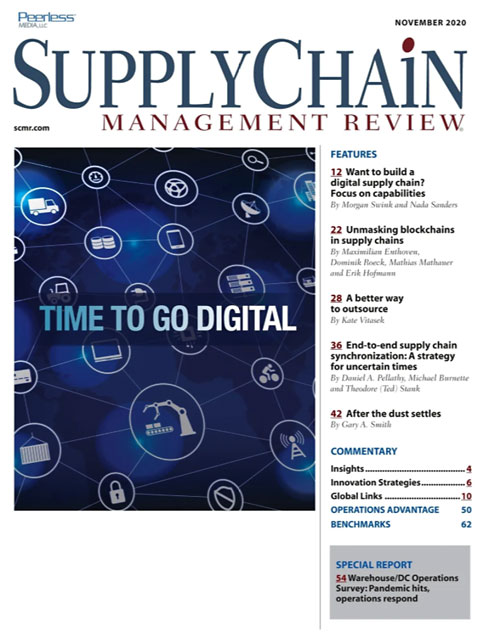Sorry, but your login has failed. Please recheck your login information and resubmit. If your subscription has expired, renew here.
November 2020
Supply chains have been in the spotlight like never before over the last eight months. That hasn’t always been a good thing. The perception, reinforced by shortages of products essential to our daily lives, is that supply chains were not up to the task and failed. The reality, as argued by MIT’s Yossi Sheffi in his new book, “The New (Ab)Normal: Reshaping Business and Supply Chain Strategy Beyond COVID-19,” is that supply chains performed as designed—they did what we expected them to do. Browse this issue archive.Need Help? Contact customer service 847-559-7581 More options
How many times have you and others in your supply chain operation asked this simple question: Is there a better way to outsource? Probably more times than you care to say. After all, finding the right balance where everyone wins in any outsourcing arrangement requires more than just a transaction-based contract. But what exactly does “more than” mean here?
Evolution of vested
That question was sufficiently compelling in 2003 that the U.S. Air Force funded a University of Tennessee (UT) research project to find out if there really was a better way to outsource. The answer was an overwhelming “yes.” And it led in 2010 to publication of the book “Vested Outsourcing: Five Rules That Will Transform Outsourcing.”
Since then, Vested outsourcing has evolved from an organized and recognized methodology to a movement of loyal followers working to change how organizations outsource. Today more than 350 companies have sent nearly 1,600 people to study Vested, as the movement is known popularly, in one or more UT courses offered in its Certified Deal Architect program. To date, 57 companies have employed the Vested methodology in an effort to improve their outsourcing relationships.
This is the story of how a simple research question had a lasting impact on making outsourcing relationships as successful as everyone hopes them to be.

This complete article is available to subscribers only.
Log in now for full access or start your PLUS+ subscription for instant access.
SC
MR
Sorry, but your login has failed. Please recheck your login information and resubmit. If your subscription has expired, renew here.
November 2020
Supply chains have been in the spotlight like never before over the last eight months. That hasn’t always been a good thing. The perception, reinforced by shortages of products essential to our daily lives, is that… Browse this issue archive. Access your online digital edition. Download a PDF file of the November 2020 issue.How many times have you and others in your supply chain operation asked this simple question: Is there a better way to outsource? Probably more times than you care to say. After all, finding the right balance where everyone wins in any outsourcing arrangement requires more than just a transaction-based contract. But what exactly does “more than” mean here?
Evolution of vested
That question was sufficiently compelling in 2003 that the U.S. Air Force funded a University of Tennessee (UT) research project to find out if there really was a better way to outsource. The answer was an overwhelming “yes.” And it led in 2010 to publication of the book “Vested Outsourcing: Five Rules That Will Transform Outsourcing.”
Since then, Vested outsourcing has evolved from an organized and recognized methodology to a movement of loyal followers working to change how organizations outsource. Today more than 350 companies have sent nearly 1,600 people to study Vested, as the movement is known popularly, in one or more UT courses offered in its Certified Deal Architect program. To date, 57 companies have employed the Vested methodology in an effort to improve their outsourcing relationships.
This is the story of how a simple research question had a lasting impact on making outsourcing relationships as successful as everyone hopes them to be.
SC
MR


Latest Supply Chain News
Latest Podcast

 Explore
Explore
Procurement & Sourcing News
- Benchmarking the complexity of ESG reporting
- Looking back at NextGen 2024
- The Corporate Sustainability Due Diligence Directive
- How to make your CFO a supply chain superfan
- AI is moving omnichannel closer to the customer
- E-tailing update: Brick-and-mortar retailers struck back
- More Procurement & Sourcing
Latest Procurement & Sourcing Resources

Subscribe

Supply Chain Management Review delivers the best industry content.

Editors’ Picks





